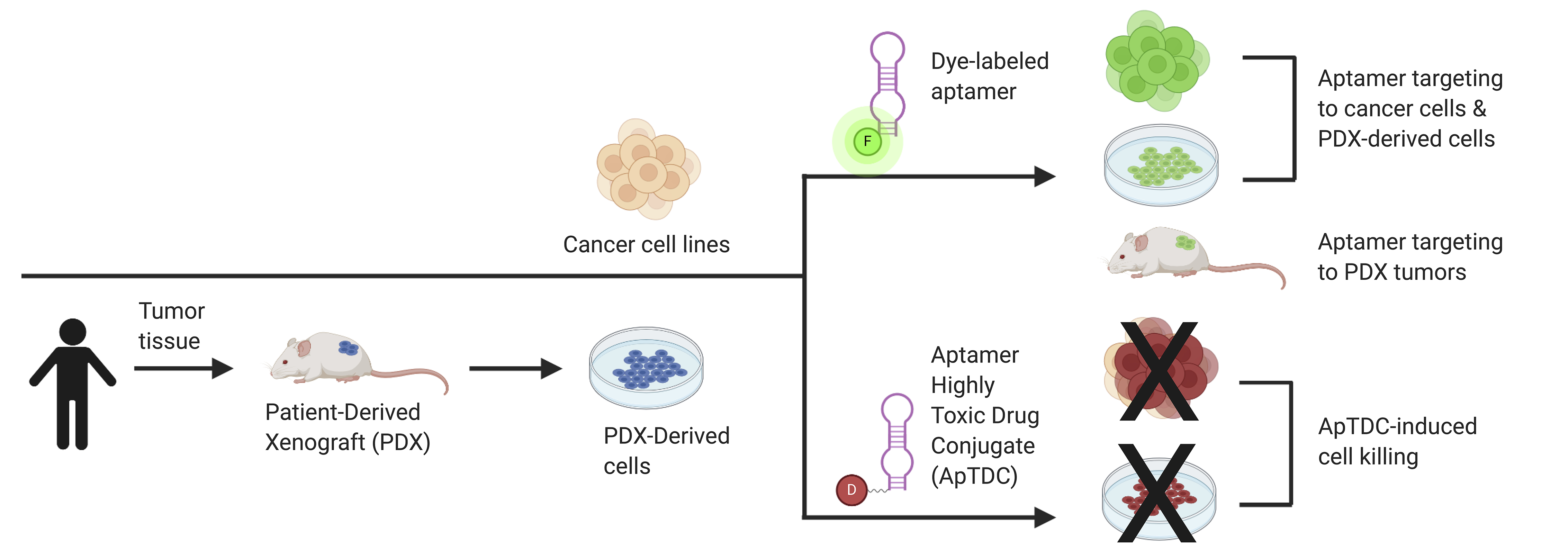Targeted therapy is the strategies employed by of most current tumor drugs, but in fact many of them have poor selectivity and certain off-target toxicity. Correspondingly, an approach that becomes increasingly prominent is to use specific ligands to elevate drug selectivity.
Antibodies are a major recognition ligand widely used in ADC development over the past few decades. Similarly, in an ApDC, the antibody is replaced with an aptamer that is connected with the drug molecule via a linker. The drug exerts its curative effect, and the aptamer acts as a recognition ligand to guide the therapeutic drug to reach disease sites or to modulate the biological function of targeted biomarkers.
Aptamers have many advantages over antibodies:
1) The screening efficiency of aptamer is high, which only takes a few days to several months.
2) Aptamers can be used if corresponding antibodies cannot be found against toxins or antigens with low immunogenicity.
3) The solid-phase synthesis technology of nucleic acid is relatively mature, with low cost and slight batch difference.
4) Aptamers are easier to modify.
5) Better thermal stability and chemical stability.
6) The molecular weight is smaller and the tissue permeability is better.
7) Almost has no immunogenicity and causes no immune side effects.
Aptamers are often used in combination with various therapies, such as chemotherapy, phototherapy, toxins, gene therapy, and vaccines.
1. Aptamer-conjugated chemotherapeutics
Traditional chemotherapeutic drugs have serious toxicity due to off-target effects, so it is essential to selectively deliver chemotherapeutic drugs to tumor tissues. Aptamers can be conjugated with various chemotherapeutic drugs, thanks to their chemical stability, as well as the mature synthesis and site-directed modification techniques.
2. Aptamer-conjugated nucleic acids
The research on gene therapy deepens owing to the continuous improvement of the human genome and disease genome, with emerging technologies like virus-based gene delivery, RNA interference, antisense oligonucleotides, and gene editing. Although huge achievements have been made with novel techniques, there is still room to improve in selectivity, so aptamers are expected to play a role in the selective delivery of gene therapy.
Attempts have been made to couple aptamers to small interfering RNA (siRNA), small hairpin RNA (shRNA) and microRNA (miRNA) for the treatment of cancer or some autoimmune diseases.

(Bethany Powell Gray et al., Cancers, 2020)
3. Aptamer-coupled proteins/peptides
Proteins and peptides can also be used as drugs, but only a few have good selectivity. There are also many proteins and peptides that are not selective, so coupling them with aptamers can solve this problem well.
4. Aptamer-coupled photosensitizer
Photodynamic therapy (PDT) is a novel non-invasive therapy, which relies on the irradiation of a specific wavelength of light to activate photosensitizers in tumor tissue to generate biologically toxic singlet oxygen and other reactive oxygen species (ROS), thereby producing killing effect on tumor cells. Although the treatment site can be manipulated by controlling the irradiation range, the photosensitizer still needs to be delivered to a specific tissue or organ in advance, which it can be considered for delivery by means of aptamers.
5. Aptamer-conjugated photochemical reagents
In general, nanomaterials are used to encapsulate other therapeutic molecules, which, in fact, can also be used as therapeutic molecules and are often employed in photothermal therapy (PTT). Photothermal nanomaterials include gold nanomaterials (nanorods, nanoshells, nanocages, nanoparticles, and nanocomposites), nanomaterials containing dopamine, carbon nanomaterials (nanographene, nanographene oxide, and carbon tube), hybrid nanocomposites (gold-graphene oxide composites), which can be utilized as targeted therapy after coupling with aptamers.
Summary
There are also problems with aptamers in spite of their multiple advantages over antibodies.
1) The aptamer generated by SELEX technology can have high affinity, but not necessarily biological activity.
2) Nucleic acid aptamers are easily degraded by nucleases.
For the first problem, aptamers are generally used in combination with other therapeutic methods to prepare various aptamer conjugates. In response to the second problem, nucleic acids can be chemically modified or encapsulated by structures such as nanomaterials.
